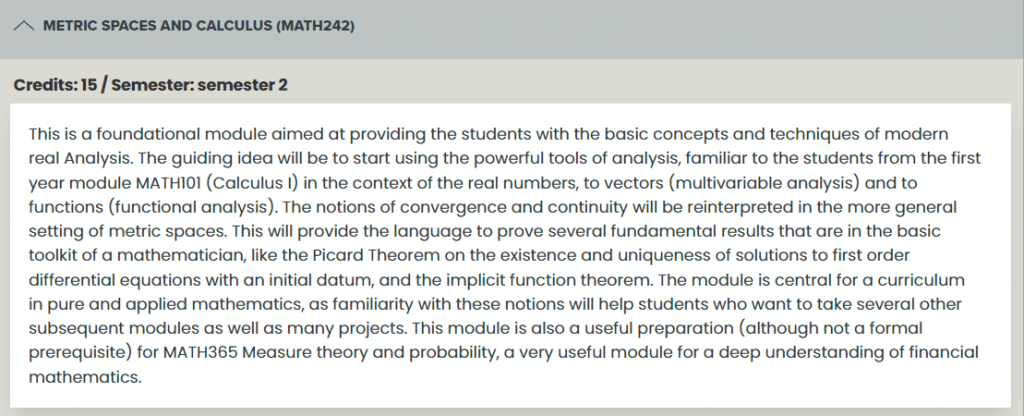Assignment-daixieTM为您提供利物浦大学University of Liverpool METRIC SPACES AND CALCULUS MATH242度量空间和微积分代写代考和辅导服务!
Instructions:
Metric spaces and calculus are two important areas of mathematics that are closely related to each other.
A metric space is a set of points, along with a metric or distance function that assigns a non-negative real number to every pair of points in the set. The metric satisfies certain properties such as the triangle inequality, which states that the distance between any two points in the set is always less than or equal to the sum of the distances between those points and a third point in the set. Examples of metric spaces include Euclidean space, the space of continuous functions, and the space of square integrable functions.
Calculus, on the other hand, is the branch of mathematics that deals with the study of rates of change and accumulation. It includes the study of limits, derivatives, integrals, and differential equations. Calculus is used in many areas of science and engineering, such as physics, economics, and engineering.
The study of calculus is closely related to metric spaces, as calculus often involves the analysis of functions defined on metric spaces. In particular, the concept of continuity, which is central to calculus, is closely related to the topology of a metric space. The notions of limit, derivative, and integral can all be defined in the context of metric spaces, and many of the results of calculus carry over to more general metric spaces.

Let $\gamma$ be the semi-circle connecting $(0,0)$ and $(2,0)$ that sits in the half plane where $y \geq 0$. Given $\mathbf{f}(x, y)=\left(2 x+\cos y,-x \sin y+y^7\right)$, calculate $\int \mathbf{f} \cdot d \gamma$. If your calculation requires justification from a theorem we proved in class, state the theorem you are using.
Notice that $D_1 f_2(x, y)=-\sin y=D_2 f_1(x, y)$. Since $f(x, y)$ is defined on all of $\mathbb{R}^2$, which is convex, we conclude $f(x, y)$ is a gradient field. Thus the integral of $f(x, y)$ from $(0,0)$ to $(2,0)$ is independent of the path. Let us integrate on a straight line $s:[0,2] \rightarrow \mathbb{R}^2$ defined by $s(t)=(t, 0)$ :
$$
\int_C\left(2 x+\cos y,-x \sin y+y^7\right) d s=\int_0^2\left(2 t+\cos 0,-t \sin 0+0^7\right) \cdot(1,0) d t=\left[t^2+t\right]_0^2=6
$$
Let $f(x, y, z)=x^2+y^2+z^2$. Prove $f$ is differentiable at $(1,1,1)$ with linear transformation $T(x, y, z)=2 x+2 y+2 z$.
Solution To prove $f$ is differentiable with total derivative $T$ as described we need to show
$$
\lim {|\mathbf{v}| \rightarrow 0} \frac{f(\mathbf{v}+(1,1,1))-f(1,1,1)-T(\mathbf{v})}{|\mathbf{v}|}=0 $$ Now observe that $$ f(\mathbf{v}+(1,1,1))-f(1,1,1)-T(\mathbf{v})=\left(v_1+1\right)^2+\left(v_2+1\right)^2+\left(v_3+1\right)^2-3-2 v_1-2 v_2-2 v_3=v_1^2+v_2^2+v_3^2 $$ Thus $$ \lim {|\mathbf{v}| \rightarrow 0} \frac{f(\mathbf{v}+(1,1,1))-f(1,1,1)-T(\mathbf{v})}{|\mathbf{v}|}=\lim {|\mathbf{v}| \rightarrow 0} \frac{|\mathbf{v}|^2}{|\mathbf{v}|}=\lim {|\mathbf{v}| \rightarrow 0}|\mathbf{v}|=0 .
$$
It follows that $f$ is differentiable at $(1,1,1)$ with the total derivative as described.
Consider $f(x, y)=(x y+y)^{10}$ on the square $Q=[0,1] \times[0,1]$. Evaluate $\iint_Q f d x d y$.
The function
$$
f(x, y)=(x y+y)^{10}
$$
is continous on $\mathbb{R}^2$. Thus, $\int_0^1 f(x, y) d x$ is integrable for all $y \in[0,1]$ so one can apply Fubini’s Theorem to get:
$$
\iint_Q(x y+y)^{10} d x d y=\int_0^1 \int_0^1(x y+y)^{10} d x d y=\int_0^1\left[\frac{(x y+y)^{11}}{11 y}\right]_0^1 d y=\int_0^1 \frac{\left(2^{11}-1\right) y^{10}}{11} d y=\frac{2047}{121}
$$
